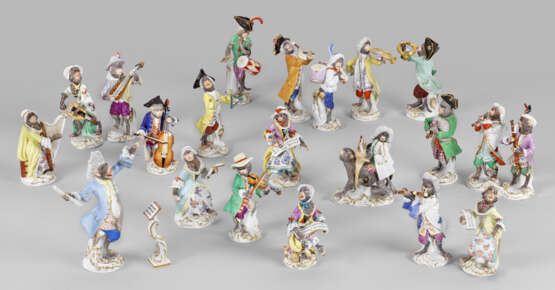ID 801300
Lot 840 | Vollständige Sammlung der Meissener Affenkapelle
Estimate value
€ 16 000 – 32 000
22-tlg.; Auf reliefiertem Rocaillesockel einundzwanzig stehende bzw. sitzende Figuren eines Kapellmeisters mit Pult, Geigers, Baßgeigers, Klarinettisten, einer Harfistin, eines Paukenschlägers bzw. -trägers, Trompeters, Waldhornbläsers, Triangelschlägers, Dudelsackpfeifers, Fagottspielers, Flötisten, Gitarristen, Trommlers, einer Drehleierspielerin, eines Klavierspielers und 4 Sängerinnen. Polychrome Malerei mit Goldstaffage. Entw. Johann Joachim Kaendler. Paukenschläger nach 2000. Teilw. minim. best./rest.; Schwertermarke. H. 9 cm - 17 cm.
Die unterschiedlichsten Affen der Kapelle werden in den Arbeitsberichten Johann Joachim Kaendlers und Peter Reinickes in der Zeit von 1749 und 1766 erwähnt. Bereits 1753 gestaltete Kaendler ein Ensemble musizierender Affenfiguren in farbenfroher Kleidung mit affektiert wirkendem Ausdruck, die er in Zusammenarbeit mit Peter Reinicke um 1765/1766 nochmals überarbeitete. Woher Kaendler die Idee zur Affenkapelle nahm, ist unklar. Bereits in der großen Tierplastik eines Affen mit Dose von 1732 gibt der Modellmeister auf komisch-satirische Weise einen Tabak schnupfenden Affen beim Ausführen einer zu dieser Zeit gängigen Gewohnheit wider. Darstellungen von Tieren mit menschlichen Eigenschaften und Verhaltensweisen erfreuten sich nicht zuletzt wegen des hohen Interesses an Fabeldichtungen im 18. Jh. höchster Beliebtheit, vor allem in den sog. "Singerien" französischer Künstler, die kuriose, szenische Darstellungen von menschlich agierenden Affen in verschiedenen Situationen zeigten. Aufgenommen wurde das Thema unter anderem in satirischen Malereien von Christophe Huets, wie in "Grande Singerie" und "Petite Singerie" im Schloss Chantilly, aber auch in einem Kupferstich Jean-Jacques Filiparts (1719 - 1782).
Vgl. Rückert, Kat. Bayer. Nationalmuseum, S. 192, Sonntag, Affenkapelle aus Meissener Porzellan, S. 29ff.; Pietsch, Meißner Porzellanplastik, Nr. 213.
A complete 22-piece collection of porcelain figures from the "monkey orchestra" modelled by J. J. Kaendler and P. Reinicke. Timpani beater after 2000. Partly minor chipped/restored. Crossed swords mark.
Meissen. 2. Hälfte 19. Jh.
| Address of auction |
Kunstauktionshaus Schloss Ahlden GmbH Große Str. 1 29691 Ahlden(Aller) Germany | ||||||||||||||
|---|---|---|---|---|---|---|---|---|---|---|---|---|---|---|---|
| Preview |
| ||||||||||||||
| Phone | +49 5164 80100 | ||||||||||||||
| Buyer Premium | 25.0 | ||||||||||||||
| Conditions of purchase | Conditions of purchase | ||||||||||||||
| Business hours | Business hours
|



